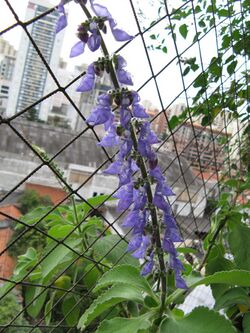Biology:Plectranthus barbatus
| Indian coleus | |
|---|---|

| |
| Scientific classification | |
| Kingdom: | Plantae |
| Clade: | Tracheophytes |
| Clade: | Angiosperms |
| Clade: | Eudicots |
| Clade: | Asterids |
| Order: | Lamiales |
| Family: | Lamiaceae |
| Genus: | Plectranthus |
| Species: | P. barbatus
|
| Binomial name | |
| Plectranthus barbatus Andrews
| |
| Synonyms[1] | |
|
List
| |
Plectranthus barbatus, also known by the synonym Coleus forskohlii and vernacular names forskohlii[2] and Indian coleus, is a tropical perennial plant related to the typical coleus species. It produces forskolin, an extract useful for pharmaceutical preparations and research in cell biology.[3]
Name
The Brazilian name is boldo brasileiro (Portuguese pronunciation: [ˈbowdu bɾɐziˈlejɾu], or boldo gaúcho, as opposed to the Chilean true boldo), boldo-da-terra ([ˈbowdu dɐ ˈtɛʁɐ]), boldo-de-jardim ([ˈbowdu dʒi ʒaʁˈdʒĩ]) or tapete-de-Oxalá ([tɐˈpetʃi dʒ oʃaˈla]) (Oxalá's carpet, because of its velvety texture).
Chemistry
Herbal teas made from Plectranthus barbatus contains rosmarinic acid and also flavonoid glucuronides and diterpenoids.[4][5] The chemical constituents of Plectranthus barbatus showed activities in vitro, such as acetylcholinesterase inhibition.[3][4][5]
Forskolin, which derives its name from the former binomial name Coleus forskohlii, is a constituent of Plectranthus barbatus.[3][6]
Ayurveda
In Ayurvedic traditional medicine, Coleus has been used to treat heart diseases, spasmodic pain, painful urination and convulsions.[7]
References
- ↑ "The Plant List: A Working List of All Plant Species". http://www.theplantlist.org/tpl/search?q=Plectranthus+barbatus.
- ↑ "Plectranthus barbatus". Natural Resources Conservation Service PLANTS Database. USDA. https://plants.usda.gov/core/profile?symbol=PLBA2. Retrieved 7 October 2015.
- ↑ 3.0 3.1 3.2 Alasbahi, R. H.; Melzig, M. F. (2010). "Plectranthus barbatus: A review of phytochemistry, ethnobotanical uses and pharmacology - Part 1". Planta Medica 76 (7): 653–61. doi:10.1055/s-0029-1240898. PMID 20178070. https://www.thieme-connect.com/products/ejournals/html/10.1055/s-0029-1240898.
- ↑ 4.0 4.1 Falé, P.L., Borges, C., Madeira, P.J.A., Ascensão, L. (2009). "Rosmarinic acid, scutellarein 4′-methyl ether 7-O-glucuronide and (16S)-coleon E are the main compounds responsible for the antiacetylcholinesterase and antioxidant activity in herbal tea of Plectranthus barbatus ("falso boldo")". Food Chem. 114 (3): 798–805. doi:10.1016/j.foodchem.2008.10.015.
- ↑ 5.0 5.1 "Antiacetylcholinesterase and antioxidant activities of Plectranthus barbatus tea, after in vitro gastrointestinal metabolism". Food Chem. 122: 179–187. 2010. doi:10.1016/j.foodchem.2010.02.044.
- ↑ Pizzorno, Joseph E.; Murray, Michael T. (2012). Textbook of Natural Medicine (4th ed.). Edinburgh: Churchill Livingstone. p. 686. ISBN 9781437723335.
- ↑ "Pharmacological studies on coleonol, a hypotensive diterpene from Coleus forskohlii". J Ethnopharmacol 3 (1): 1–13. 1981. doi:10.1016/0378-8741(81)90010-6. PMID 7193263.
External links
- PLANTS Database image
- Plectranthus barbatus: A Review of Phytochemistry, Ethnobotanical Uses and Pharmacology - Part 1
- Plectranthus barbatus: A Review of Phytochemistry, Ethnobotanical Uses and Pharmacology - Part 2
- Photos and description of Plectranthus barbatus (www.ethno-botanik.org)
Wikidata ☰ Q311226 entry


